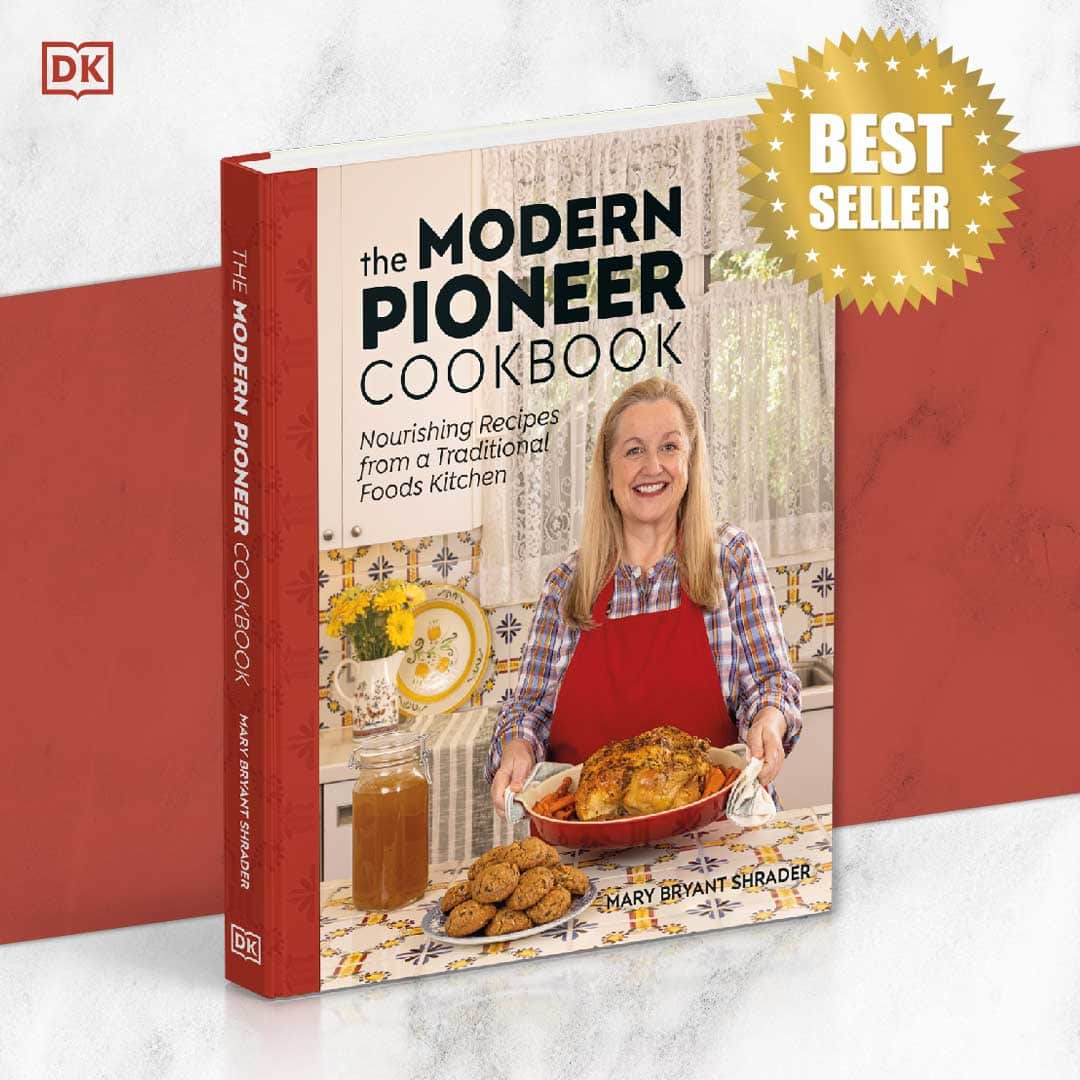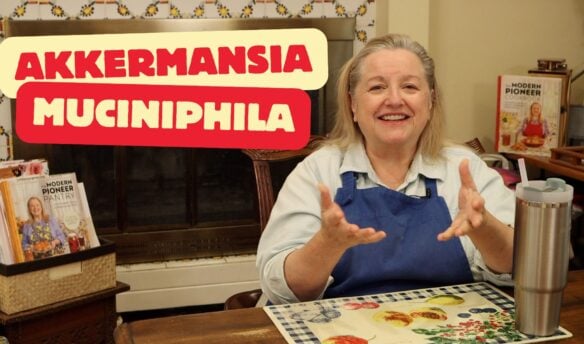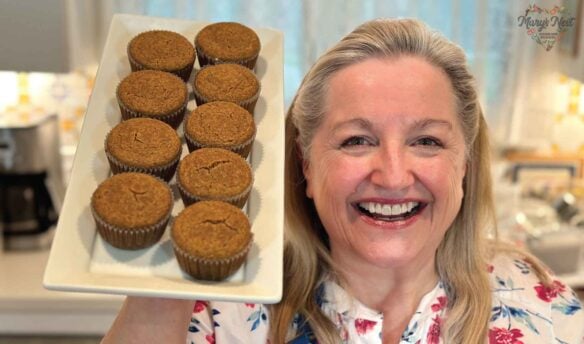Learning how to bake with whole grain soaked flour can make your breads lighter in texture and much easier to digest. And this process is surprisingly easy if you like a change of pace from baking with sourdough or sprouted grains.
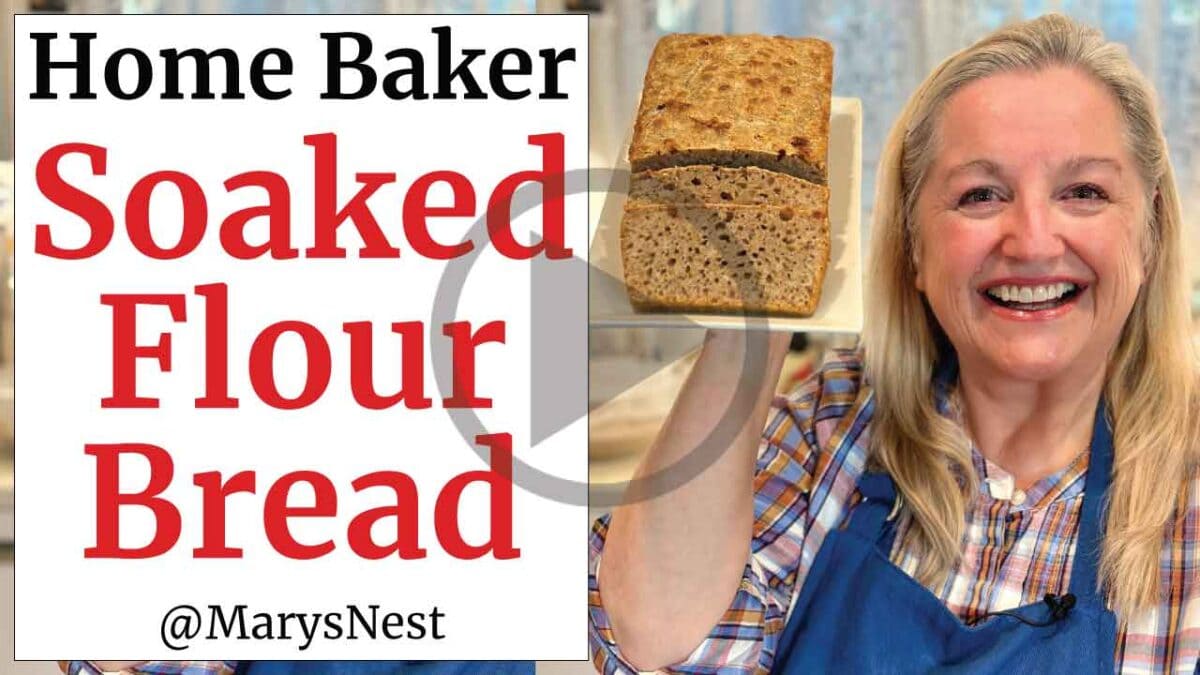
Affiliates note: As an Amazon Associate I earn from qualifying purchases. My content may contain affiliate links to products and services. If you click through and make a purchase, I’ll receive a small commission. It does not affect the price you pay.
Table of Contents
- What is Soaked Flour?
- How Do You Use Soaked Flour?
- Ingredients to Make Soaked Flour Bread
- How to Make Soaked Flour Bread
- Variations
- Recipe Tips
- Storing and Reheating
- How to Use Soaked Flour Bread
- A Home Baker’s Thoughts About Soaked Flour Bread
- Grind Your Own Flour with the Mockmill
- Download Your Free 36-Page Pantry List
- The Modern Pioneer Cookbook
- Join the Traditional Foods Kitchen Academy
- Kitchen Academy Videos
- No Knead Soaked Flour Bread Recipe Recipe
- Shop for items used in this blog post or video
What is Soaked Flour?
Soaked flour is any type of whole grain flour that is placed in a bowl, has an acidulated liquid added to it, and is left to soak anywhere from 12 to 24 hours. We follow this process to soak flour to help reduce the phytic acid in the flour.
Whole grain flour with its bran and germ contains phytic acid, which is an anti-nutrient. Phytic acid can strip vitamins and minerals from our body and interfere with our digestive tract’s ability to absorb nutrients from the food we eat.
However, this soaking process isn’t able to deactivate all the phytic acid in the flour, but that’s okay, because phytic acid also acts as an antioxidant. These antioxidants help to slow down oxidation (cell damage) in our bodies.
So by soaking whole grain flour, we are able to moderate the level of phytic acid to reduce its negative effects and encourage its beneficial attributes. We neutralize some of the phytic acid so that we can absorb nutrients from our food, but we still have some of the phytic acid remaining to act as beneficial antioxidants.
But putting all the science aside, an added benefit to soaking whole grain flour is that it simply creates a lighter end product—our baked good—that is easier to digest.
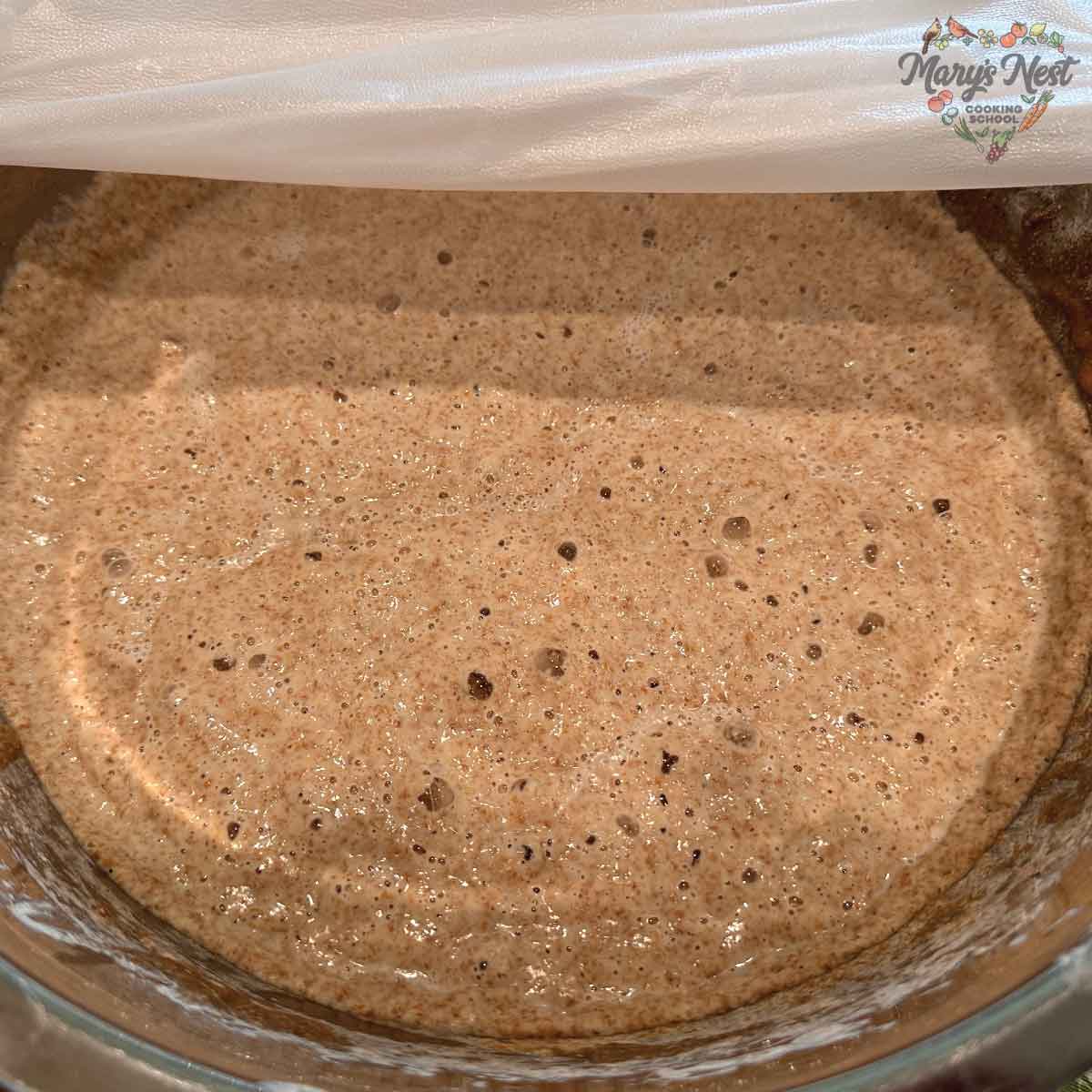
How Do You Use Soaked Flour?
You can use soaked flour in a variety of ways to make:
- Quick bread, such as with muffins in my “How to Bake with Soaked Flour to Maximize Nutrition” recipe
- Pancakes and waffles, and
- Yeasted breads, as we are making here.
Soaked flour also provides you an option to baking without a sourdough starter or sprouted flour.
Whenever we are baking with whole grains, remember that we want to neutralize some of the phytic acid in the grains, and soaking the whole grain flour helps moderate the phytic acid level, as we described earlier.
Reducing the level of phytic acid is not a concern when baking with all-purpose flour or bread flour where the bran and germ have been sifted out of the flour. That’s why you don’t need to soak these types of flours. However, baked goods made from flours that no longer contain the bran and the germ are less nutritious.
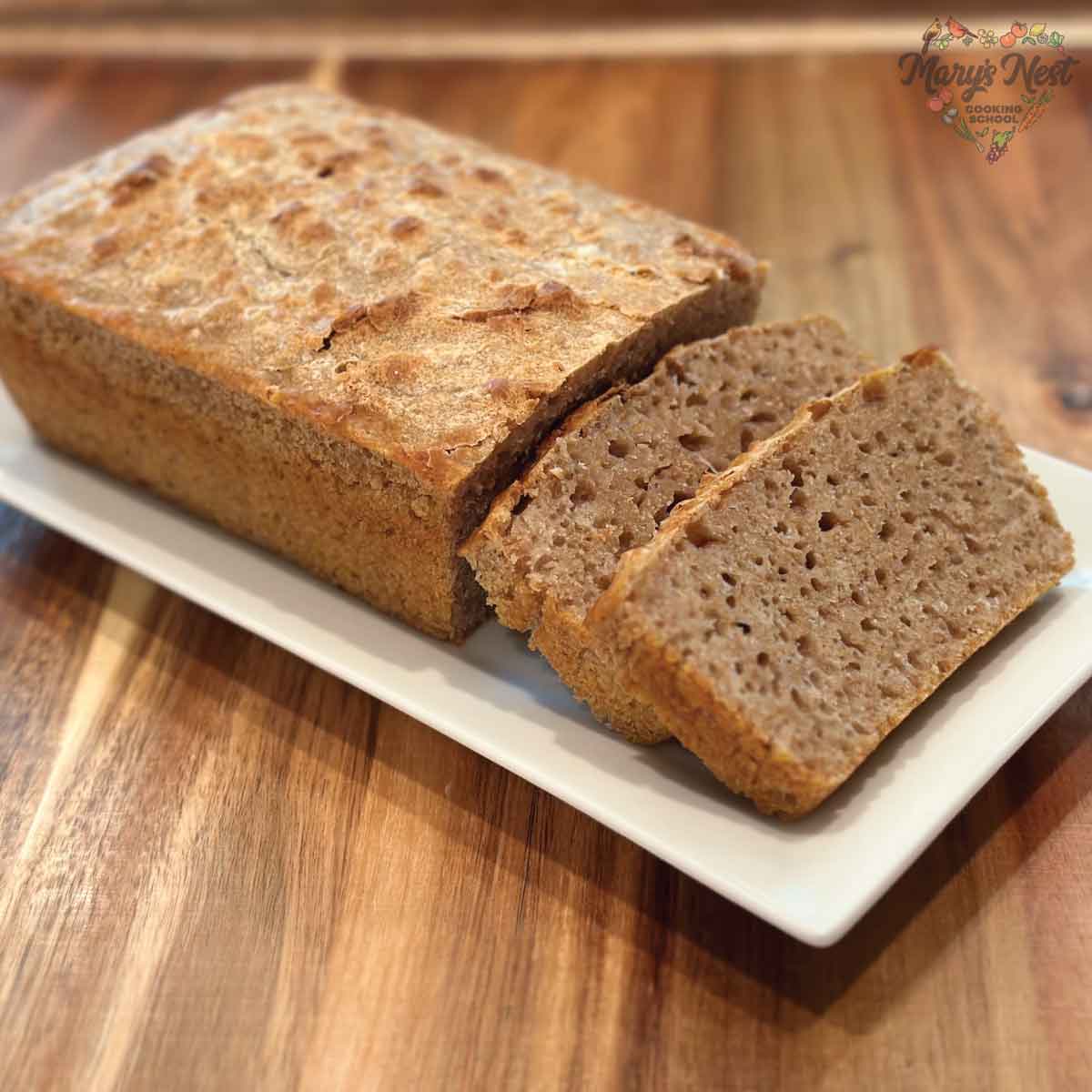
Ingredients to Make Soaked Flour Bread
Find the full printable recipe with ingredients below.
You’ll need the following ingredients to make soaked flour bread. These are common supplies, so chances are you already have most of the ingredients in your pantry.
- Whole Grain Flour, any variety including hard red wheat, spelt, or einkorn. (To learn more about the different whole grains, watch my Wheat Berries FAQ video.)
- Buttermilk, or other type of acidulated liquid.
- Water, preferably chlorine-free.
- Packaged Yeast, preferably 1 small package of yeast, which is equal to 2 1/4 teaspoons.
- Maple Syrup, or another whole sweetener, such as honey, coconut syrup, etc.
- Salt, preferably a fine ground sea salt.
How to Make Soaked Flour Bread
Find the full printable recipe with measurements below.
Soaked Flour Preparation Steps

To make Soaked Flour Bread, you will first need to make soaked flour by following these steps:
- Start with Whole Grain Flour – Place whole grain flour in a large bowl.
- Add Buttermilk – To the bowl, add 1 cup of buttermilk or buttermilk substitute.
- Mix – Mix the flour and the buttermilk together.
- Add Water – To the bowl, add 4 cups of water—1 cup at a time—and mix well.
- Soak – Cover the bowl with plastic wrap or other type of covering and allow the flour to soak for 12 to 24 hours.
Soaked Flour Baking Steps
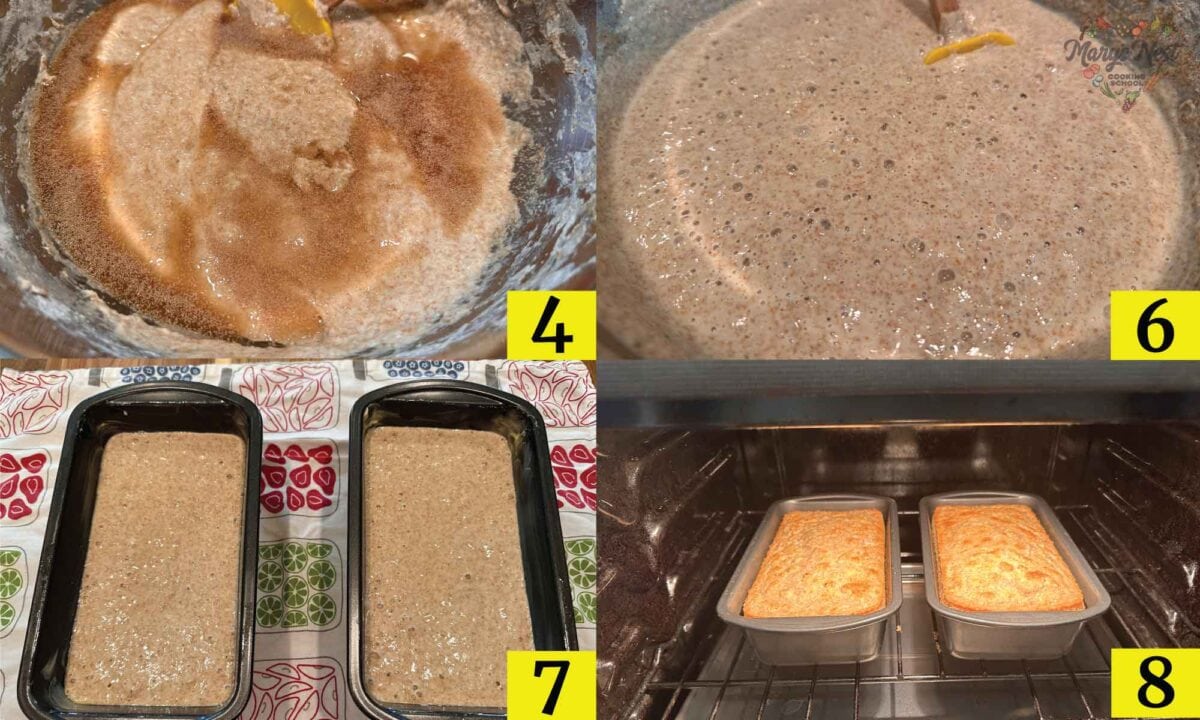
Once the flour has soaked for 12 to 24 hours, you can now proceed with making Soaked Flour Bread:
- Add Water – Start by adding a half cup of water to a measuring cup.
- Include Sweetener – Add the sweetener to the water and stir well.
- Add Yeast – To the sweetened water, add the yeast and stir well.
- Mix Soaked Flour Ingredients – Pour the sweetened yeast water into the bowl with the soaked flour and mix well.
- Add Salt – Add the salt to the soaked flour and mix well.
- Rest – Cover the soaked flour and allow it to rest for 1 1/2 hours.
- Pour Batter – Divide the batter into 2 well-greased loaf pans and allow it to rest for approximately 45 minutes.
- Prepare to Bake – Place the loaf pans into an oven preheated to 350°F (177°C) and bake for approximately 40 minutes.
Variations
Try these variations for your soaked flour bread recipe.
- Buttermilk – In this recipe, I use buttermilk to create the acidulated liquid in which I soak my flour. You can use real buttermilk, buttermilk from the grocery store, or a buttermilk substitute.
- Dairy Free – If you want to keep this recipe dairy-free, you can use water to which you have added vinegar or lemon juice. If you decide to use vinegar, apple cider vinegar imparts the best flavor to the bread. (Learn how to make apple cider vinegar from apple scraps in my series of step-by-step videos.)
Make Your Own REAL Buttermilk
If you would like to learn how to make real buttermilk, I show you how during the process of making cultured butter. It’s easy to do, and the taste of the butter and the real buttermilk can’t be beat!
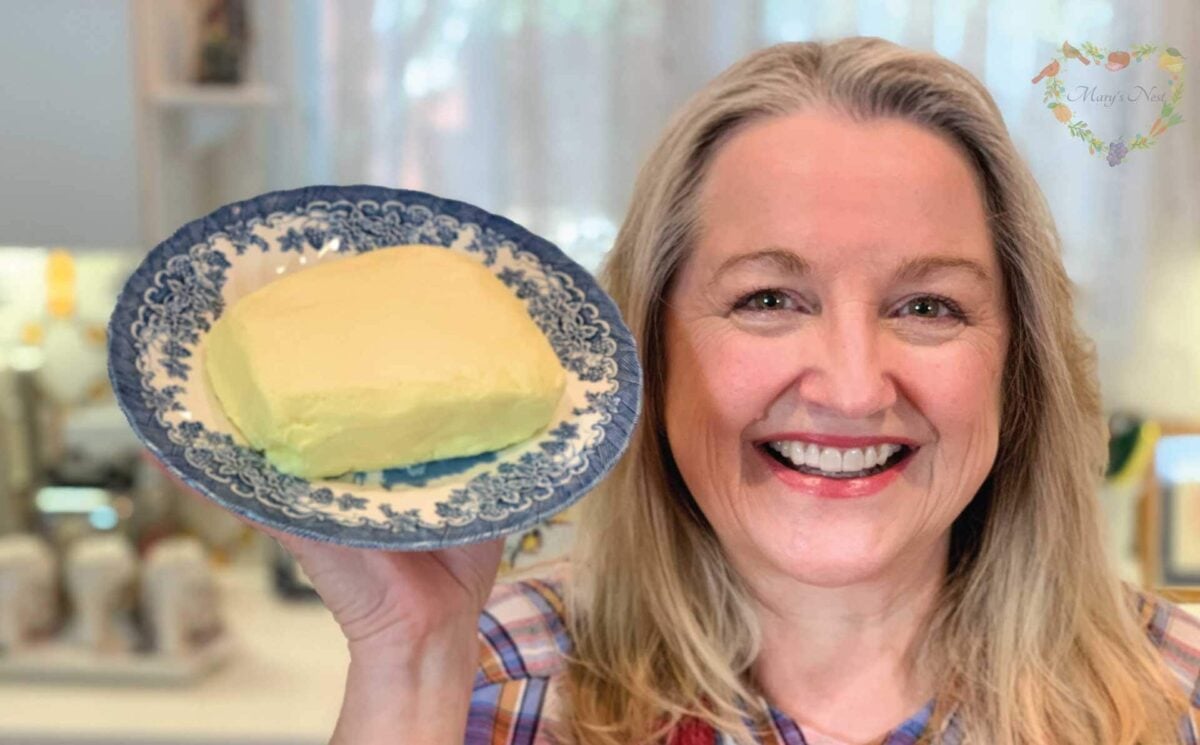
In case you don’t have a chance to make real buttermilk and can’t find any at your local grocery store, not to worry. I also show you 4 ways to make buttermilk substitutes.
Recipe Tips
These recipe tips will help your soaked flour bread come out perfect.
The Learning Curve – First and foremost, I want to share that baking with soaked flour does have a bit of a learning curve. Soaked flour bread, although loosely based on old-fashioned batter breads, creates a batter that is quite a bit thinner than traditional batter breads. And developing a feel for exactly how thin the batter should be after being soaked can take a bit of trial and error.
Consistency of the Batter – In my No-Knead Soaked Flour Bread recipe video, I show you the consistency of the batter I used to bake my soaked flour bread. However, sometimes different kitchen conditions, including oven variations and the indoor temperature to the weather outside, can have an effect on what the consistency of the batter should be to produce the right type of bread in your oven. But hang in there. It may take a few tries to get the consistency right. And even if your bread doesn’t come out perfect, you can use it to make a strata breakfast casserole or bread pudding, which is a recipe in my book, The Modern Pioneer Cookbook.
Baking with 100% Whole Grain Flour – With your soaked flour baked bread, you are eventually hoping to achieve a baked good with quite a few air pockets, making it quite similar in texture to English Toasting Bread or English Muffin Bread with one exception. Whenever you bake with whole grain flour, especially if you bake with 100% whole grain flour, baked goods tend to be more dense. So you need to be prepared for this when you first slice into your bread. This is a hearty, dense bread, but because the flour has been soaked, it is also an airy bread filled with lots of nooks and crannies. It makes a wonderful breakfast bread, perfect for the toaster.
Dry Climate vs. Damp or Humid Climate – I live in a relatively dry climate in Central Texas. If you live in a damp or humid climate, you will most likely need less liquid added to your batter than I am adding in my video. Be sure to read the recipe below carefully and take your particular climate conditions into consideration.
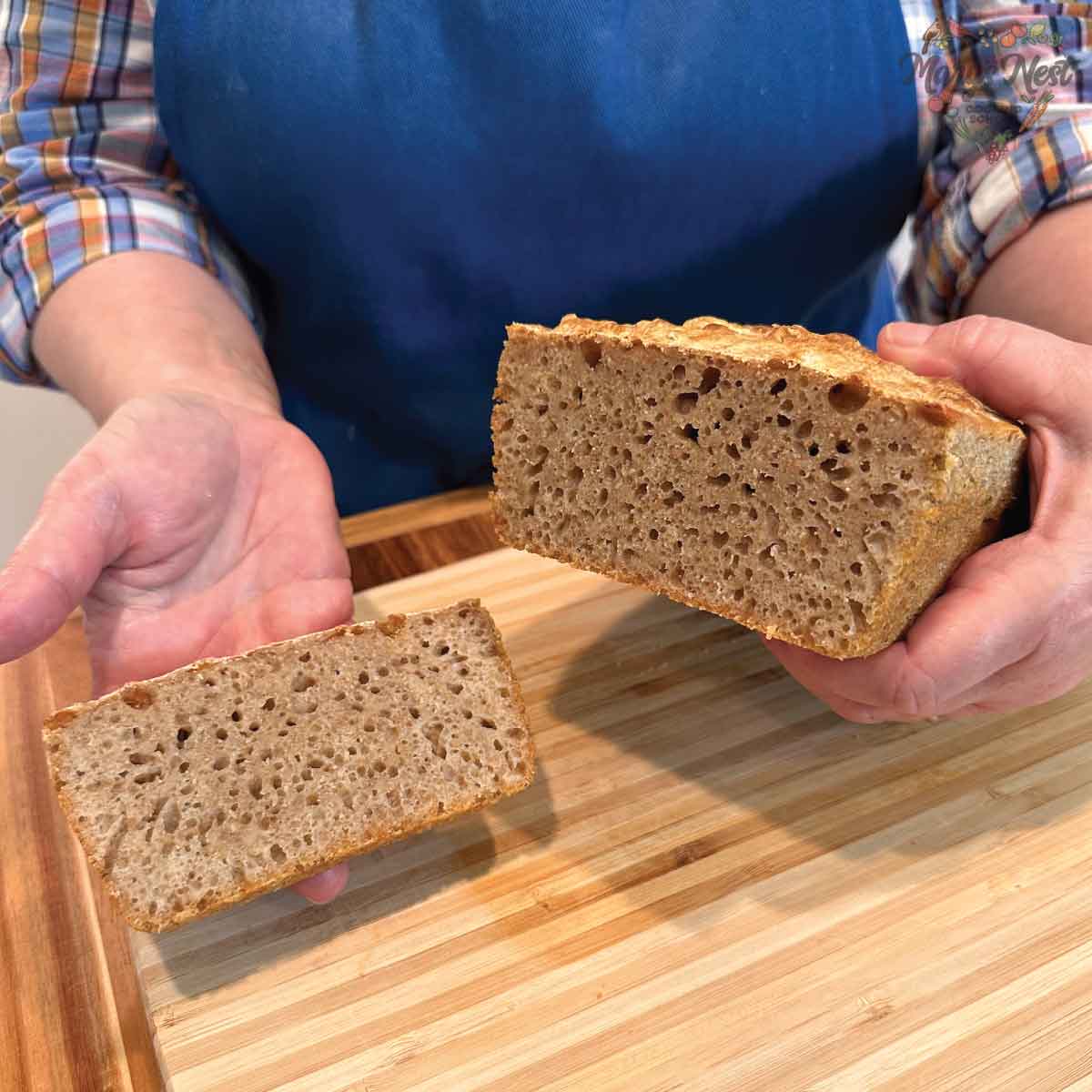
Storing and Reheating
Well wrapped, you can store soaked flour bread in the refrigerator for 2-3 days and in the freezer for 2-3 months. It is best enjoyed toasted when coming right out of the refrigerator.
If used when coming out of the freezer, allow the frozen bread to defrost, come up to room temperature, and then toast it. And when I recommend toasting this bread, it should be well toasted to help it dry out a bit and become crisp.
How to Use Soaked Flour Bread
Soaked Flour Bread is best used as a toasting bread if made with 100% whole grain flour. If you decide to make this bread with some of the whole grain flour replaced with all-purpose flour or bread flour, the final product will be considerably lighter in texture and can work well as a sandwich bread.
A Home Baker’s Thoughts About Soaked Flour Bread
Sourdough
Overall, my preferred way to bake bread is with a sourdough starter, but sourdough is often best for baking breads that are yeast-based. In the case of sourdough, it’s wild yeast, but it is yeast nonetheless. Sourdough does not always lend itself easily to making quick breads. (Sourdough, by its very nature, is not quick!)
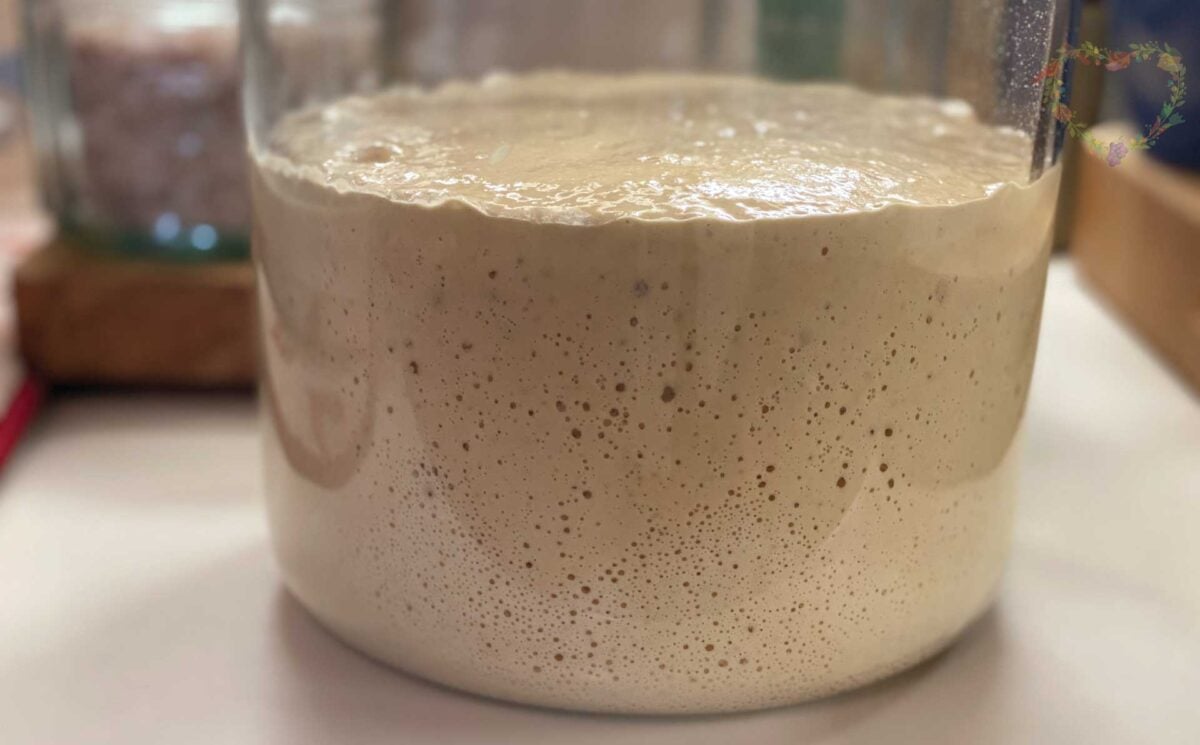
Sprouted Flour
For quick breads, I prefer to use sprouted flour, such as with my banana crunch sprouted flour bread. Baking quick breads with sprouted flour eliminates the need to soak the flour because the grain was already soaked prior to being turned into flour. And having sprouted flour on hand allows my quick breads to be just that: quick.
Soaked Flour Quick Breads
When it comes to baking with soaked flour, you can be relatively successful in making a quick bread that is light in texture as well as tasty. But quick? Not so much. Since you have to soak your flour overnight, there is not spontaneity, as my sweet friend Michele over at Chocolate Box Cottage would say. And she is 100% correct. A lot of planning goes into making quick breads with soaked flour!
Soaked Flour Yeasted Breads
Now, what about yeasted breads? If you are used to baking with a sourdough starter, then the overnight soaking process that goes into baking with soaked flour won’t bother you. If you are used to baking bread with unsoaked flour, such as all-purpose or bread flour, and packaged yeast, the process of making and baking soaked flour bread is not going to go as quickly as that or produce a type of bread you may be used to.
An Alternative Way to Bake
If you are looking for a way to bake whole grain bread that will be more digestible—and maybe you want a break from sourdough or baking with sprouted flour—this soaked flour bread may be an option for you. Just remember, be patient with yourself. And I’ll emphasize there is a learning curve to baking this type of bread (and for some, the learning curve can be significant).
But if you prepare yourself for a bit of trial and error as you venture into this foray with soaked flour, you will be better prepared. Who knew there was so much drama when it came to baking bread with soaked flour? 🤣
Grind Your Own Flour with the Mockmill
When making Soaked Flour Bread, I usually start with the actual whole grain and use my grain mill to make freshly milled whole grain flour. It can’t be beat!
When it comes to electric grain mills, after I did A LOT of research, I decided to buy a Mockmill. And am I so happy I did! The Mockmill is a very affordable but beautifully crafted German-made mill that stone grinds grain with settings ranging from 1 to 10—fine to coarse ground grain.
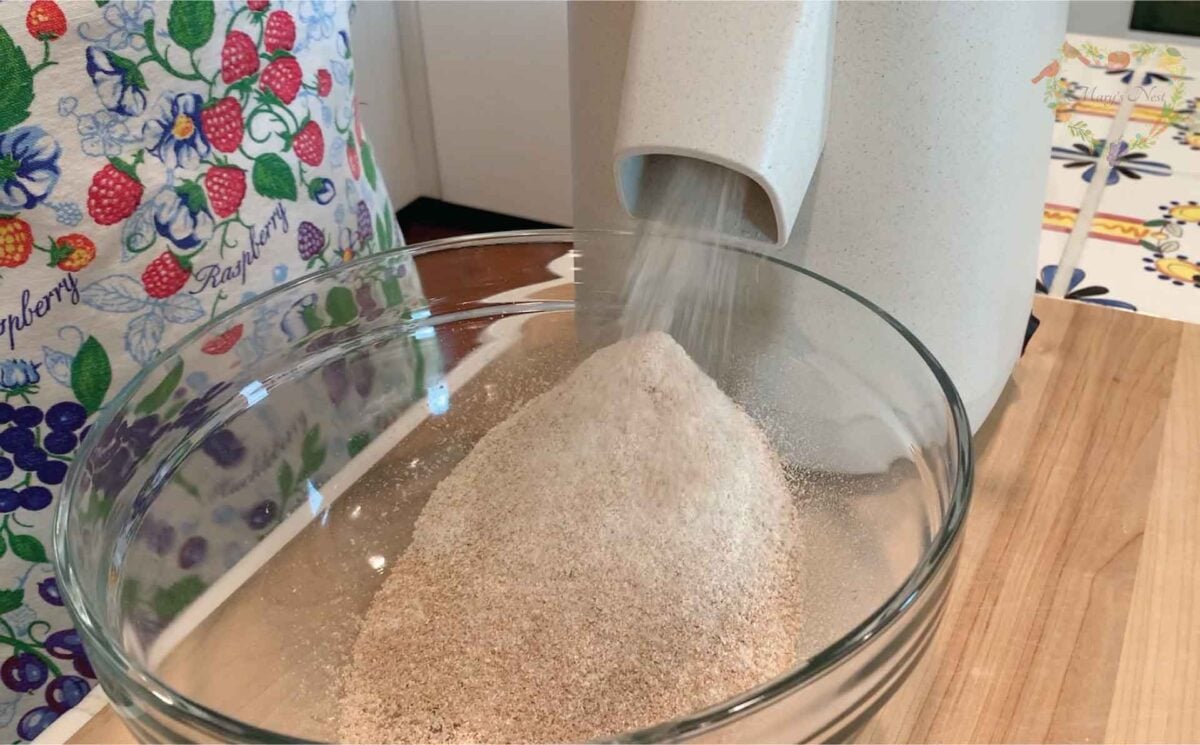
Learn more about Mockmill electric grain mills for making fresh flour and their Flake Lover’s Flaker that flakes whole grain in minutes. (This is not a sponsored post, I bought the Mockmill products that I show you, and I’m a happy user of their devices in my kitchen.)
- Mockmill 100 Grain Mill unboxing
- Get the Mockmill 100 Stone Grain Mill (Same product I show you my unboxing video.)
- Flake Lover’s Flaker from Mockmill in action (Using this device, you can flake whole grain in minutes.)
Download Your Free 36-Page Pantry List
For an extensive list of the traditional foods you can make and purchase to stock your pantry, be sure to download my free 36-page Traditional Foods Pantry List. This comprehensive eBook is full of links to recipe videos, helpful articles, and more!
And if you’re looking for a printed book full of my traditional foods recipes that shows you how to create a traditional foods kitchen, be sure to order your copy of my new book, The Modern Pioneer Cookbook.
Join the Traditional Foods Kitchen Academy
Are you looking for more traditional foods videos? If so, I invite you to join the Traditional Foods Kitchen Academy. Members of this optional paid YouTube community get access to exclusive videos, live streams, and other members-only perks. Plus, your YouTube comments include a special members-only badge.
Kitchen Academy Videos
Let’s Talk Akkermansia: A Tiny Helper for Big Gut Health
Discover how Akkermansia muciniphila supports gut and immune health—and how traditional foods help this mighty microbe thrive.
How to Eat a Mediterranean Diet with a Keto Twist
Explore a Mediterranean-Keto twist with a full sample menu focused on healthy fats, quality proteins, and low-carb veggies.
Traditional Foods Kitchen Academy 2025 Member Update
I chat about what’s in store for my Traditional Foods Kitchen Academy in 2025.
Stay in Touch with Mary’s Nest
- Subscribe to My YouTube Channel for Traditional Foods Videos (Free) - When you subscribe, be sure to click on the notification bell that will let you know each time I upload a new video.
- Subscribe to Mary’s Traditional Foods Newsletter (Free) - Get a free 36-page eBook for signing up: How to Stock Your Essential Traditional Foods Four-Corners Pantry.
- Join the Traditional Foods Kitchen Academy - For more detailed videos and exclusive members-only perks, join my YouTube membership community.
- Order The Modern Pioneer Cookbook - Get a hardcover book of Mary's nourishing recipes from a Traditional Foods Kitchen. This bestselling cookbook is published by Penguin Random House with their DK imprint.
- Preorder The Modern Pioneer Pantry - Be one of the first to get Mary's hardcover book about preserving food and making delicious meals from your Four Corners Pantry. Mary's second cookbook is also published by Penguin Random House.
I look forward to having you join me in my Texas Hill Country Kitchen!
I’d like to receive more tips and recipes from Mary’s Nest.
No Knead Soaked Flour Bread Recipe
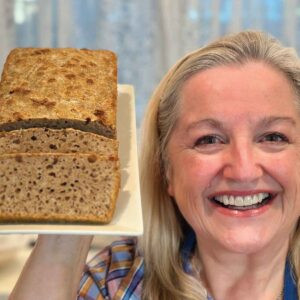
Equipment
- 2 9×5 loaf pans
- 1 Large bowl
- 1 Dry measuring cup
- 1 Liquid measuring cup
- 1 set Measuring spoons
- 1 Spatula spoon
Ingredients
- 6 cups whole grain flour
- 1 cup buttermilk Alternatively, you can use a buttermilk substitute or 3/4 water with 1/4 cup apple cider vinegar added to it.
- 4-5 cups water Preferably water that is not chlorinated.
- 2 1/4 tsp packaged yeast Instant yeast or active yeast may be used.
- 3 tbsp maple syrup Alternative sweeteners you can use include honey, coconut syrup or whole dried sweeteners, such as maple sugar, coconut sugar, etc.
- 2 1/2 tsp salt
- 2 tbsp butter, softened Alternatively, you can use olive oil or coconut oil to keep this recipe dairy-free.
- 1/2-1 cup all-purpose flour or bread flour, optional
Instructions
To Make Soaked Flour
- Place the whole grain flour into a large bowl.
- Add buttermilk to the bowl and stir to incorporate.
- Add water, 1 cup at a time, and stir well until you obtain the consistency of a loose batter. (See video for the desired consistency.)
- Cover the bowl with plastic wrap or other covering and allow the flour to soak for 12-24 hours in a warm area. The longer the soak, the lighter the baked bread will be.
- Home Baker's Note: If you are uncomfortable leaving the flour to soak at room temperature, you can transfer it to the refrigerator but allow it to soak for the full 24 hours. Once you remove the soaked flour from the refrigerator, allow it to return to room temperature before proceeding with making Soaked Flour Bread.
To Make Soaked Flour Bread
- Generously grease the 2 loaf pans with butter or butter alternative. Set aside.
- Using a liquid measuring cup, measure 1/2 cup of water and add the maple syrup (or other sweetener) and the yeast. Mix well.
- Pour the sweetened yeast water into the bowl with the soaked flour. Mix well.
- Sprinkle the salt into the bowl. Mix well.
- The batter should be quite loose, but if it appears too watery, add some all-purpose or bread flour to the bowl 1/4 cup at a time and mix well until you reach the proper consistency. (See video for the desired consistency.)
- Loosely cover the bowl and allow the soaked flour to rest in a warm location for 1 1/2 hours if using instant yeast or 1 3/4 hours if using active yeast.
- After the resting period, gently pour the batter, equally divided, between the two greased loaf pans.
- Allow the batter to rise in the loaf pans, but do not allow it to rise past the rim of the loaf pans. Approximately 45 minutes.
- Place the loaf pans on the middle rack of a 350°F (177°C) preheated oven and bake for approximately 40 minutes until the bread appears to be golden brown. If, at 30 minutes, the bread appears to be over-browning but not completely baked, tent it with aluminum foil and continue to bake.
- Once the bread is baked, remove the loaf pans from the oven and place them on a heatproof surface. Using potholders, remove the bread from the loaf pans and transfer them to a cooling rack.
- Cool completely before slicing.
- Well-wrapped, Soaked Flour Bread can be stored in the refrigerator for 2-3 days and in the freezer for 2-3 months. It is best enjoyed toasted when coming right out of the refrigerator. If being eaten when coming out of the freezer, allow the frozen bread to defrost, come up to room temperature, and then toast it.
Video
Notes
Nutrition
Shop for items used in this blog post or video
Favorite Bread Making Supplies
- Favorite Aprons
- 10-Piece Glass Bowl Set
- Glass Measuring Cup
- Measuring Cups and Spoons
- Spatula Spoon
- Metal Loaf Pans
- SAF Instant Yeast
Amazon Shop and Shopping Guide
- Visit Mary’s Nest Amazon Shop
- Visit my Shopping Guide page
Get up to 15% off for stocking your Traditional Foods Pantry and equipping your Modern Pioneer Kitchen, including discounts from US Wellness Meats, Farmhouse Teas, Lehman's, Masontops, Cultures for Health, Survival Garden Seeds, Redmond Real Salt, Plan to Eat, and More!

